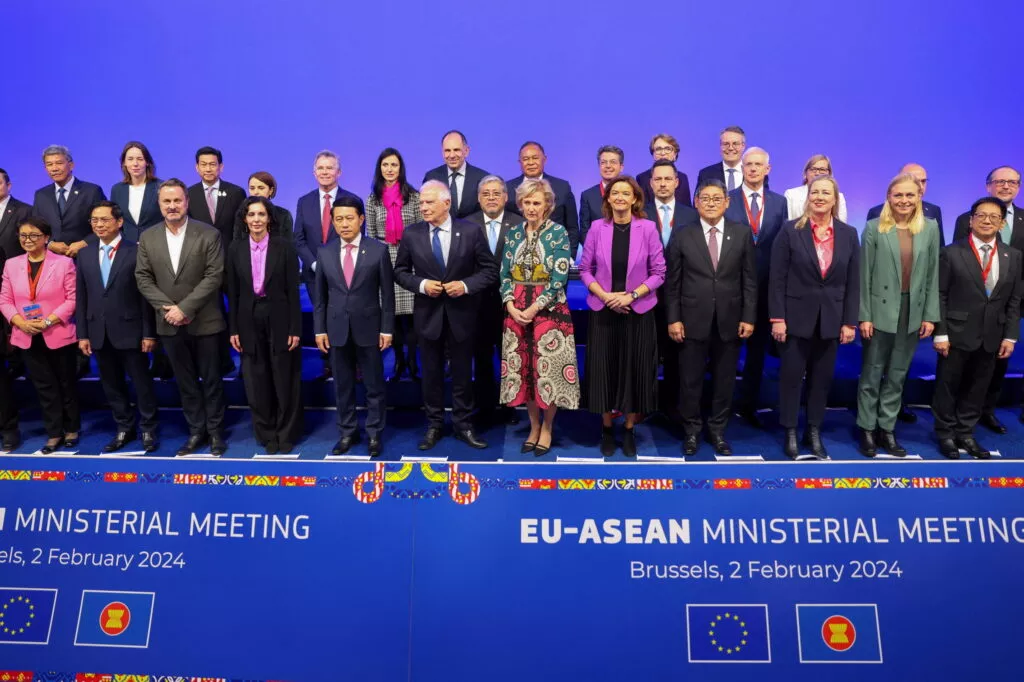
Southeast Asia faces rising US tariffs and pressure to limit Chinese links, prompting a search for stronger European trade ties. While Europe offers promising opportunities, ASEAN must navigate complex bilateral deals that may risk regional cohesion.
Southeast Asian countries risk Trumpian trade turmoil, facing mounting US tariffs — up to 46 per cent for Vietnam — and collateral damage as Washington presses them to forgo Chinese inputs, capital and technology. ASEAN nations are seeking stronger trade links elsewhere and Europe, their third-largest trading partner, should loom large in that search.
On balance, strengthening links with Europe is a sensible course for ASEAN, but the risks and opportunities need charting carefully. A key concern is ASEAN coherence. Most of the formal trade agreements under consideration are bilateral — such as Vietnam and EFTA or Indonesia, Thailand, the Philippines and Malaysia separately with the EU. These preferential deals risk complicating intra-ASEAN trade relations. Even if a broader EU–ASEAN agreement were considered a longer-term prospect, it would still be second-best to a hypothetical multilateral accord under the World Trade Organization (WTO).
The United States is not alone in attacking perceived unfair behaviour by trading partners. The EU has multiple power-based remedial measures, applied unilaterally under EU law and, somewhat improbably, justified by national security. They cover alleged discrimination in public procurement, subsidy use and intellectual property and labour rights breaches. They also address environmental standards through the contentious Deforestation Regulation — actively contested in the WTO by Indonesia and Malaysia — and the Carbon Border Adjustment Mechanism. There is wide scope for discord, and to succeed, agreements may need to extend beyond trade, requiring signatories to, for example, align emissions trading schemes.
Closer trade links with Europe also cannot reduce ASEAN’s reliance on China for global value chain (GVC) backward linkages, that is, foreign inputs to ASEAN exports. Over three decades, China’s share of ASEAN’s backward linkages has tripled, contributing greatly to ASEAN’s economic development, but also to its asymmetric dependence on China.
Yet this leads to the first upsides of closer ASEAN links with Europe. By 2018, Europe held the largest share of ASEAN’s forward GVC linkages — ASEAN exports incorporated into other countries’ exports — at 28 per cent, compared with China’s 12 per cent. ASEAN’s penetration of global markets now ranges from raw materials in French and Danish luxury goods to semiconductors in German motor vehicles.
There is also scope to build on the transformative shift towards market- and efficiency-seeking investment and production within ASEAN by European companies. Dutch, French and German firms are a major source of FDI in ASEAN financial services, machinery and chemical manufacturing. This trend will likely strengthen as Brussels too seeks refuge from US bullying and Chinese authoritarianism, as Europe also faces being flooded with subsidised Chinese manufactures that are denied access to the US market.
Vital opportunities also arise through heightened EU interest in links with the Comprehensive and Progressive Agreement for Trans-Pacific Partnership (CPTPP), which includes Brunei, Malaysia, Singapore and Vietnam. While there are no plans for the EU to join the CPTPP, a twin-track process has been mooted, comprising a joint affirmation of WTO commitments and harmonised standards in key areas such as digital trade and sustainability.
In parallel, the CPTPP has suggested that to avoid the impression of an anti-US bloc and acknowledge that some of Washington’s grievances with the WTO are justified, an agreement with the EU could also look to engage with WTO reforms.
This process offers some Southeast Asian countries — and Australia, also a CPTPP member — the chance to both strengthen economic links with Europe and address the shortcomings of the WTO, the guardian of the rules-based trading order but a body no longer fit for purpose.
To benefit fully from these potential opportunities, the overriding requirement for all the countries of Southeast Asia is to promote sustained domestic economic reform to increase resilience to trade disruption and uncertainty.
For Indonesia, one of Southeast Asia’s least GVC-linked countries, the weak technological capacity of domestic firms calls for more integrated cooperation between the government, research institutes and domestic enterprises. In the case of Thailand, the OECD observes that boosting productivity and moving to more sustainable and inclusive growth will require stepping up delayed structural reforms. And for Vietnam — at a critical point in its economic transformation, as factory wages rise above those in India — a key requirement is to extend economic activity beyond a select group of politically connected conglomerates and cumbersome state-owned enterprises that dominate industries from energy to telecoms.
Only through strength at home will the countries of Southeast Asia be able to avoid the pitfalls and maximise the manifest opportunities of closer trade and investment links with Europe.
Source: East Asia Forum
Share: